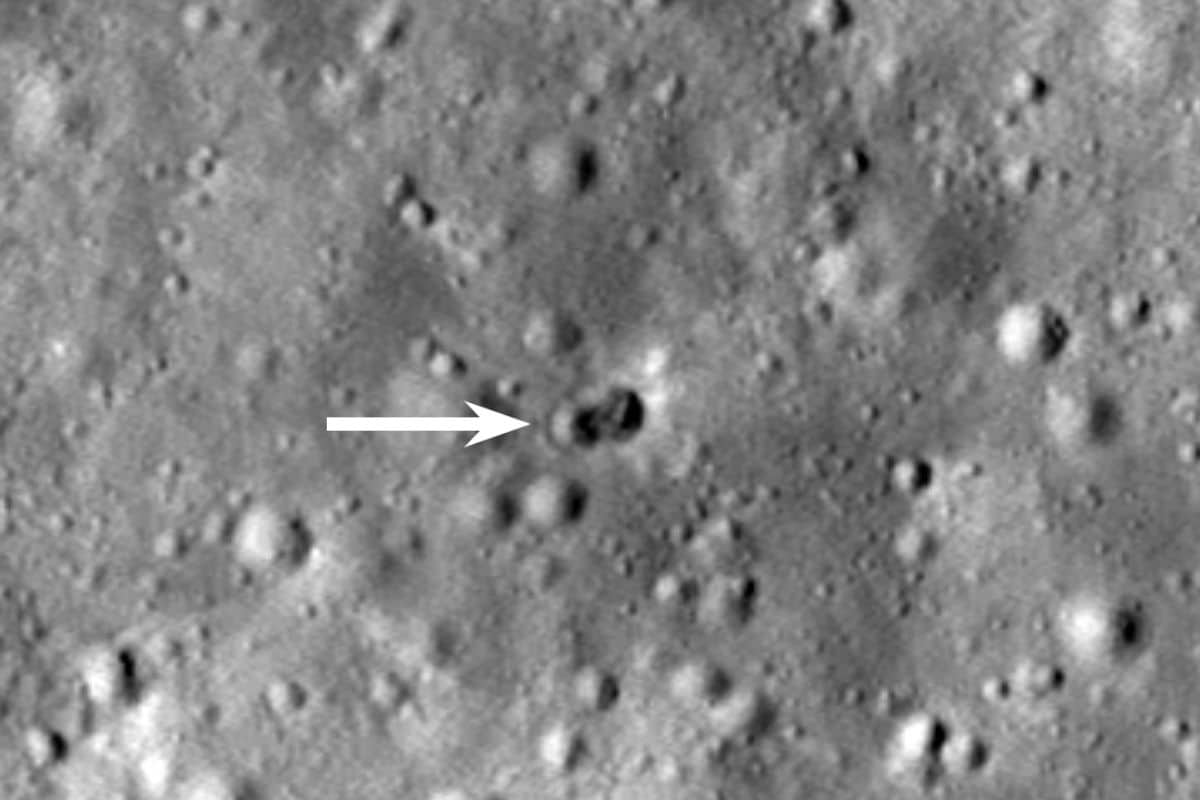

Images of the Lunar Reconnaissance Orbiter reveal that the missile part has struck a double crater. And that’s surprising.
In late January, data analysts concluded that a somewhat mysterious rocket component (see box) tumbling aimlessly through space would soon hit our moon. And on March 4, the time had come; the rocket part crashed on our natural satellite.
The rocket component that crashed on the moon in March is somewhat mysterious, as no one knows for sure where the object originated. It was initially suspected that it was a discarded rocket booster from a Falcon 9 rocket. But that theory was soon disproved. It was then suspected that it was a rocket booster from the Chang’e 5-T1, a Chinese lunar orbiter that was launched in 2014. However, the Chinese denied it.
Based on the course and speed of the mysterious missile component, researchers quickly had a good idea of where the missile component would have landed. And now it’s scientists thanks to images of the Lunar Reconnaissance Orbiter (LRO) also managed to pinpoint the exact location of the crash.
Localized
The orbiter has found a brand new crater in the area where the rocket part was expected to crash. “Without actually visiting the site, we can’t be sure that the rocket component landed here,” admits Professor Mark Robinson, part of the LRO team who specializes in lunar surface research. “But the chance that a natural object of exactly the same size would hit in exactly the right place is exceptionally small.”
So the researchers believe that the crater is the result of the rocket part that landed hard on the moon in March. But there is something strange going on with that crater. To the surprise of researchers, the mysterious rocket component has struck a double crater on the moon.

Image: NASA/GSFC/Arizona State University.
Strange crater(s)
It is surprising, because to date we are not aware of a single rocket component that crashed on the moon that left a double crater. During previous crashes – of the Apollo boosters – although somewhat erratic, a few craters were created. But for the mysterious rocket part, things are a little different. LRO has captured two craters; a 16 m wide specimen, which half overlaps with an 18 m wide crater. And both craters are new and so most likely caused by the rocket component.
Mass
The double crater may indicate that the rocket part still had a large mass at both ends. That’s unusual, because you usually see the mass of used rockets concentrated on one side. The greatest weight is located on the side of the engine. The rest of the rocket stage consists for the most part of an empty (and therefore relatively light) fuel tank.
The strange crater may help to finally determine who this unfortunate rocket stage actually belonged to. Robinson himself has come a long way; he strongly suspects that the missile part was made by the Chinese after all. He also refers to recent research from the University of Arizona. Scientists at the university studied the rocket part shortly before it crashed on the moon and based on the spectrum (of the light reflected from the rocket part) they were able to say more about the materials that made up the rocket part. And the use of materials hinted at a Chinese origin. “I think the work from the University of Arizona is correct and it’s very, very likely that it was Chang’e 5-T1’s third stage rocket,” Robinson said. “We can’t say that with 100 percent certainty, but I’m happy with 99 percent certainty.”
Future lunar settlers may be able to increase that percentage a bit if they visit the double crater. After all, we now know where to find them. It is logical that it took a while for the crater to be located, according to Robinson. “It is a matter of comparing images taken before the impact with images obtained after the impact. But since the search area was quite large, it took us a long time to look at all those pixels.” But the search has paid off. And with that – at least for the time being – the last word about the much-discussed crash seems to have been said.
What the last word has not yet been said about is the fact that we are increasingly startled by news of uncontrolled floating rocket parts and (smaller) space debris. The impact of the rocket component does not have far-reaching consequences for the moon. But it is somehow worrisome that pieces of space debris – of which we don’t even know where they come from – are hitting the moon. Because it illustrates that there is a lot of space debris floating around. The lion’s share floats around the earth, but there is also some space debris around the moon. “The idea that there are so many objects in space whose orbits and identities we don’t know is worrying,” study researcher Grace Halferty said. “We need to better manage space traffic.” Colleague Vishnu Reddy agrees. “There are only a handful of objects in orbit around the moon, but I hope this sheds new light on the growing problem of space debris. The scientific community is concerned about increasing pollution.”
Source material:
†Mystery Rocket Body Found!” – LROC
†UArizona students confirm errant rocket’s Chinese origin, track lunar collision course” – University of Arizona
Interview with Mark Robinson
Image at the top of this article: NASA / GSFC / Arizona State University